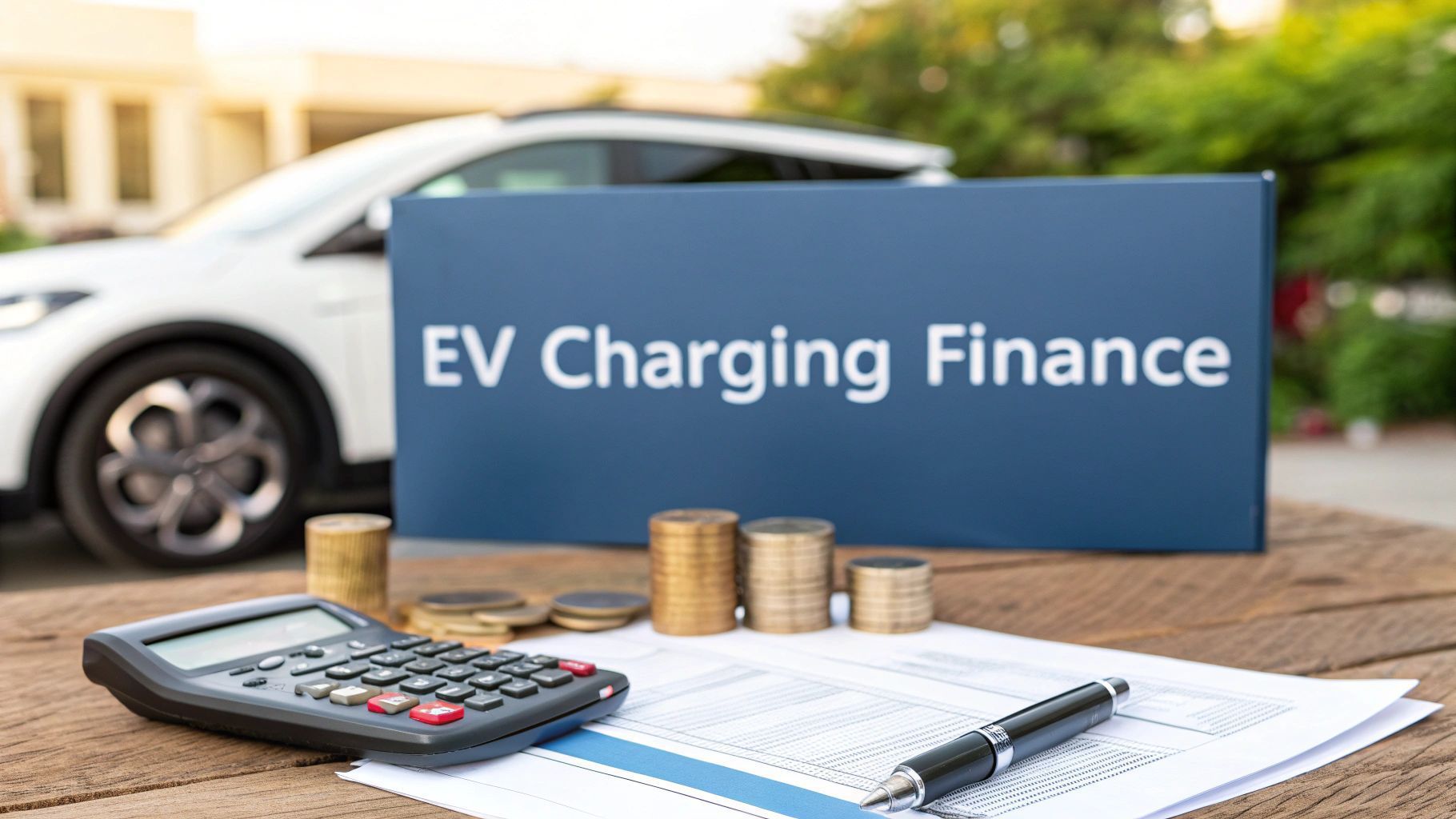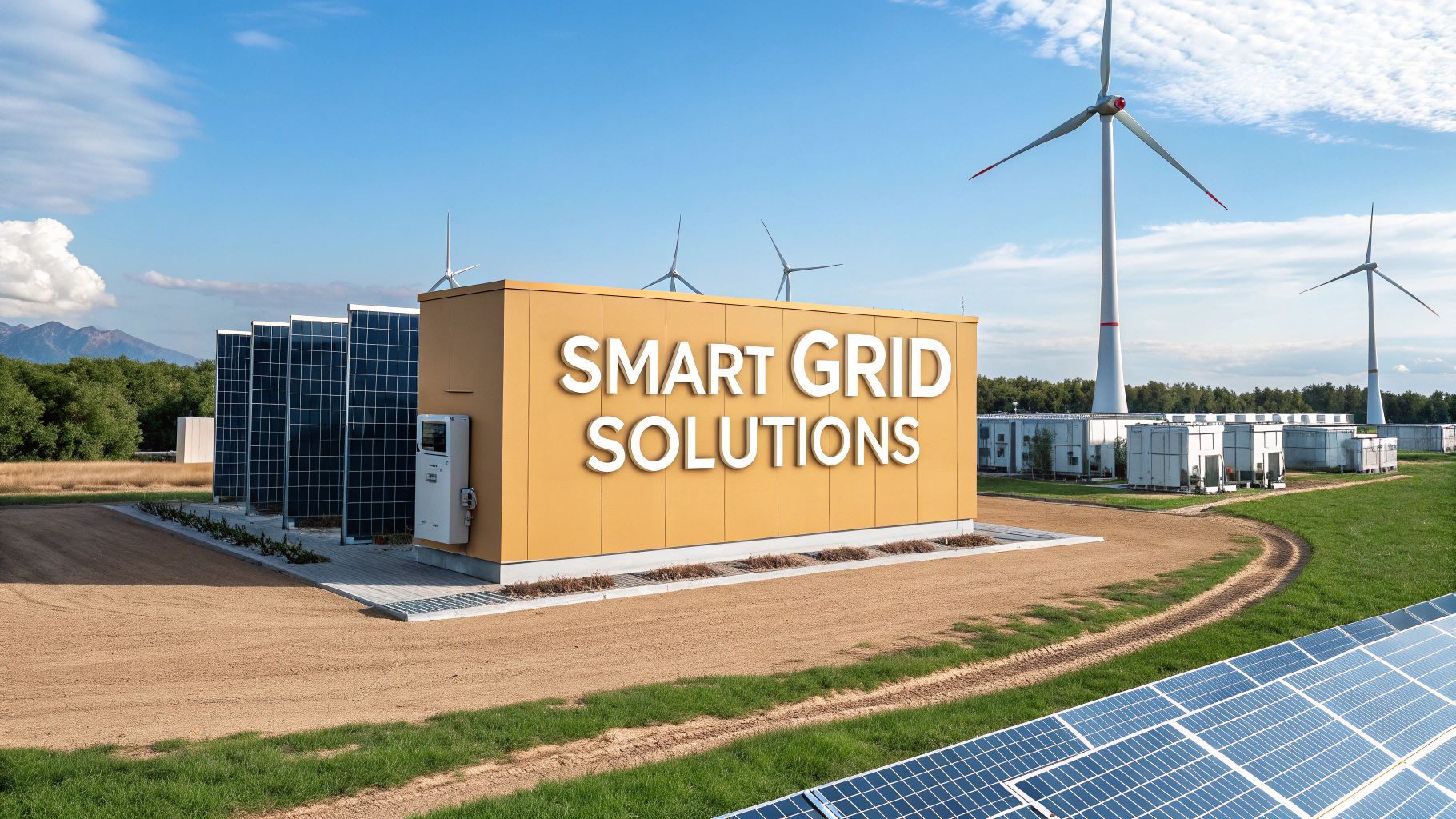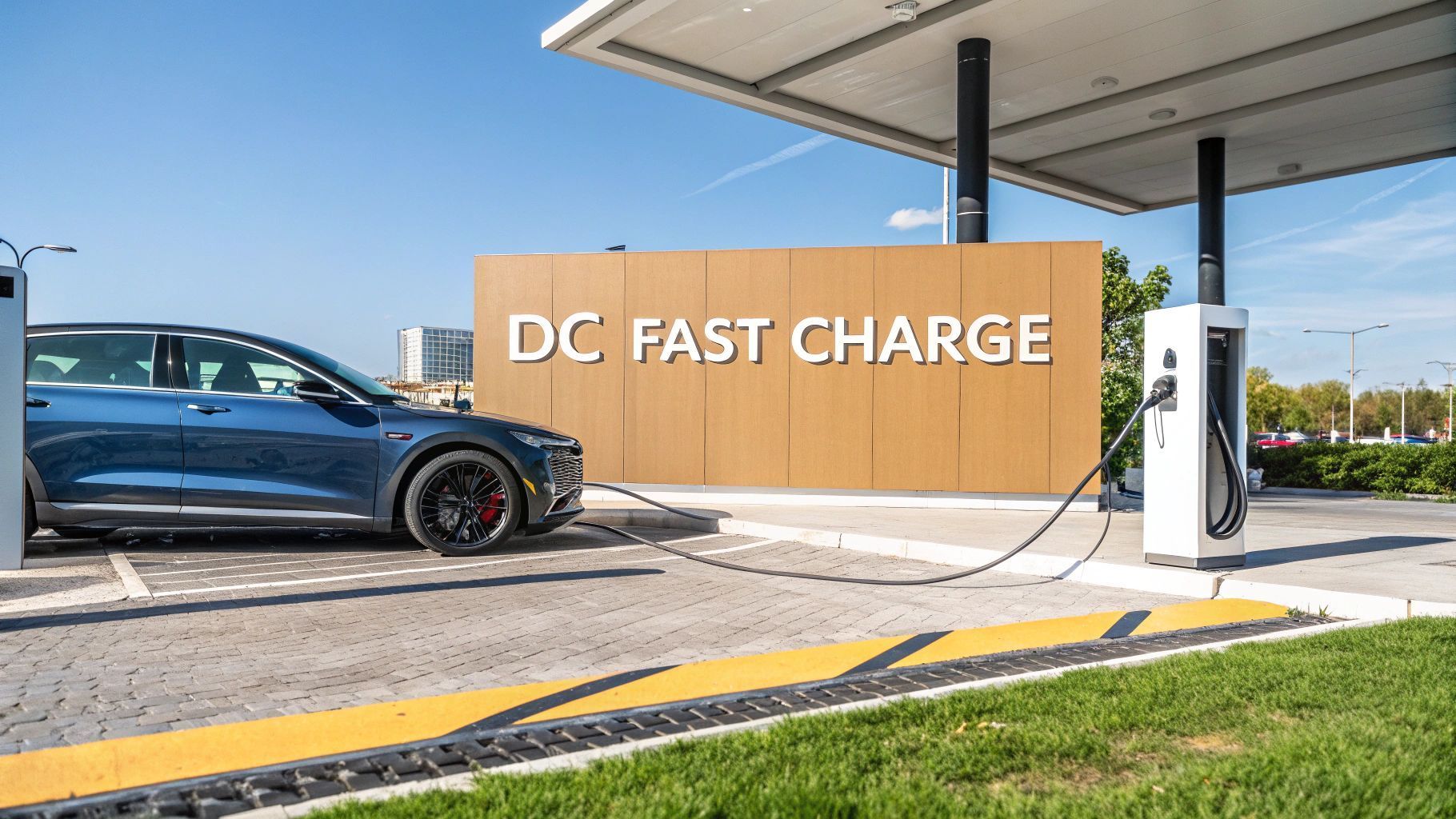Finding Your Ideal EV Charger Solution
An EV charger solution is so much more than a simple plug on a wall. It is a complete ecosystem, bringing together hardware, software and services to deliver reliable, intelligent power. This integrated approach ensures that charging—whether for a single vehicle or an entire fleet—is efficient, cost-effective and ready for what’s next. Modern solutions often blend rapid chargers, mobile units and battery storage to tackle common infrastructure headaches head-on.
Understanding the Modern EV Charger Solution
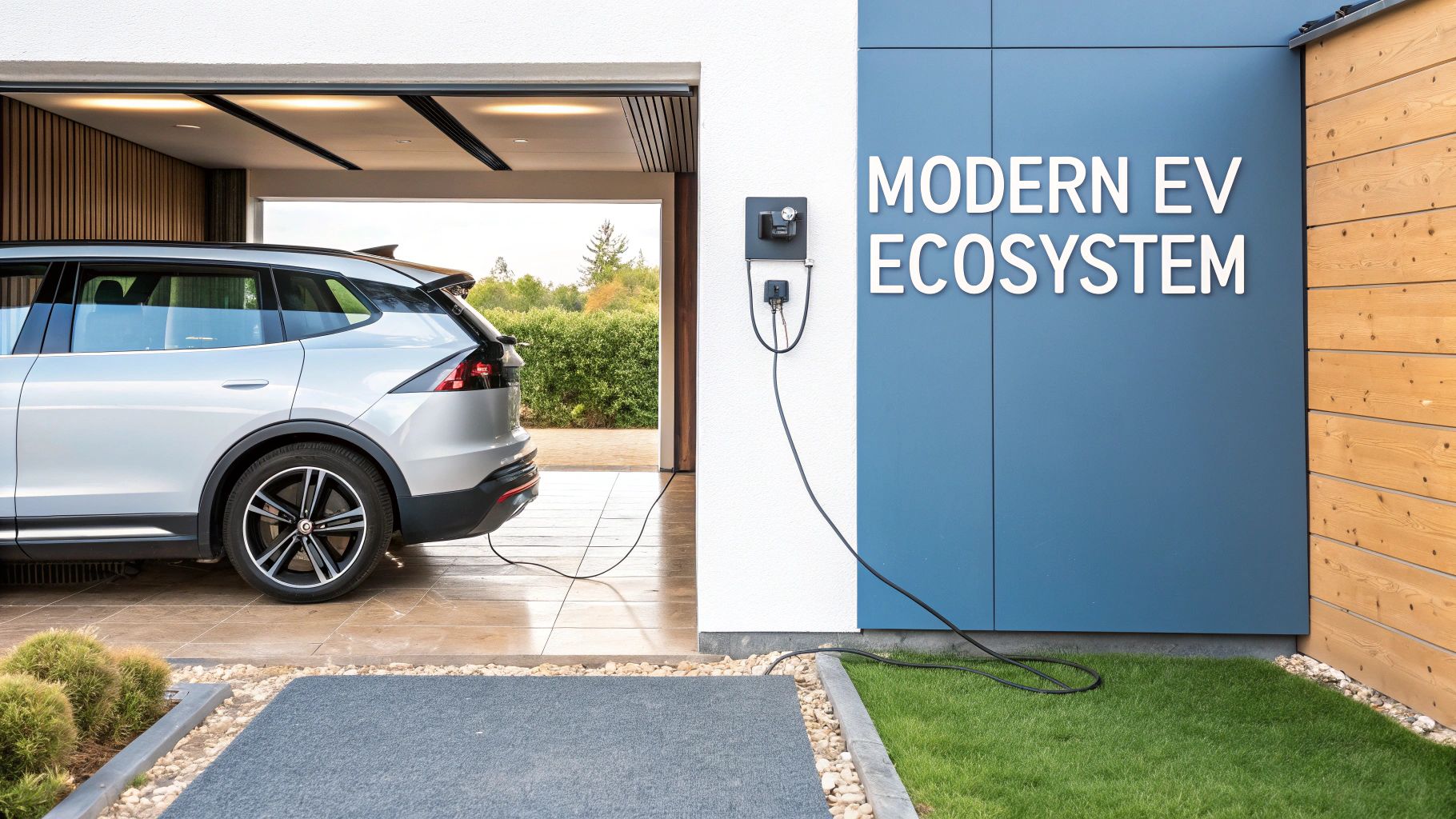
Planning for EV charging is like designing your home's entire utility system, not just buying a new appliance. It is about assessing your power needs, thinking about where that energy comes from and managing it all smartly. The real goal is to create a seamless experience that can support the ever-growing demand for electric mobility.
This shift in thinking is vital as the UK's charging infrastructure expands at a blistering pace. As of July 2025, the UK had around 84,218 publicly available EV charging devices , a 30% jump from the previous year. This growth is especially concentrated in places like Greater London, which is home to over 25,502 of these devices, highlighting the urgent need for robust, scalable systems.
The Core Components of an Integrated System
What truly defines a modern system is its ability to pull different technologies together to solve complex energy problems. It's no longer a standalone unit but a key player in a much larger distributed energy network.
Key elements often include:
- Rapid and Ultra-Rapid Chargers: For quick turnarounds in busy public or fleet settings.
- Mobile EV Charging Units: Providing flexible, on-demand power for things like roadside assistance or temporary sites.
- Grid Scale Batteries (BESS): These store low-cost energy to be used during peak times or when the grid is unavailable.
- Combined On-site Renewables: Think solar panels that generate clean, cheap electricity right where it's needed.
Beyond the Plug: Intelligent Energy Management
The real magic, however, lies in the intelligence behind the hardware. This is what truly sets a modern EV charger solution apart. A huge part of this is ensuring reliability and uptime, often boosted by advanced tools like predictive maintenance software. This kind of software can anticipate potential hardware failures, allowing for proactive servicing that prevents costly downtime.
This proactive management is essential. It transforms charging infrastructure from a passive utility into a dynamic asset that can adapt to energy market fluctuations and grid constraints, ensuring power is always available when and where it's needed most.
Ultimately, the best EV charger solution isn't a one-size-fits-all product. It's a carefully designed system built around specific operational needs. By exploring the various integrated solutions available , businesses can build infrastructure that is not only powerful today but ready for whatever the future energy landscape holds.
Exploring Different Types of EV Chargers
Getting to grips with the different types of chargers is the first step in finding the right EV charger solution for you. Not all chargers are built the same and the best choice depends entirely on your specific needs. Let's break down the main categories to see how they fit into the bigger energy picture.
Think of a fixed charger as your home broadband connection. It’s a stationary, dependable power source that’s always there when you need it, perfect for overnight charging at home or providing a reliable service at a workplace. It’s the backbone of most daily charging routines.
A mobile EV charger , on the other hand, is like a powerful mobile data hotspot. It delivers flexible, on-demand power wherever it's needed most. This makes it a brilliant solution for roadside assistance, temporary event power or for fleets that need to charge vehicles in different spots around a depot.
Fixed AC Chargers: The Everyday Powerhouse
Fixed AC chargers are the most common type you’ll come across. They supply alternating current (AC) power directly from the grid, which the vehicle’s own onboard charger then converts to direct current (DC) to top up the battery.
This kind of charging is ideal for locations where vehicles will be parked for a few hours anyway.
- Workplace Car Parks: Employees can top up their batteries throughout the workday.
- Retail and Leisure Destinations: Shoppers can plug in while they’re inside.
- Residential Properties: The most convenient and common option for overnight charging.
Because they deliver power at a slower, steadier rate—typically between 7kW and 22kW —they place less immediate strain on the local grid. This makes them a practical and cost-effective choice for widespread deployment.
Mobile EV Charging: The Flexible Response
When a fixed installation just isn't practical or possible, a mobile EV charging unit offers unmatched versatility. These systems essentially put a powerful charger on wheels, bringing the electricity directly to the vehicle.
This capability is a game-changer for fleet operators who need to charge vehicles that aren't in their usual bays or for providing emergency power to a stranded EV. They're also invaluable for powering events or construction sites where temporary charging is needed without the cost and commitment of a permanent installation.
Rapid DC Charging: The Motorway Pit Stop
If a fixed AC charger is the daily top-up then rapid DC charging is the motorway service station of the EV world. It delivers a powerful charge of DC electricity straight to the vehicle's battery, completely bypassing the car's slower onboard converter. This allows for a much, much faster charge, often adding over 100 miles of range in as little as 20 minutes .
This speed is absolutely crucial for long-distance travel and for high-use commercial fleets that simply cannot afford long periods of downtime. It transforms the viability of electric vehicles for journeys that extend far beyond the daily commute.
To help visualise how these chargers stack up, this infographic provides a clear comparison of their power and typical use cases.
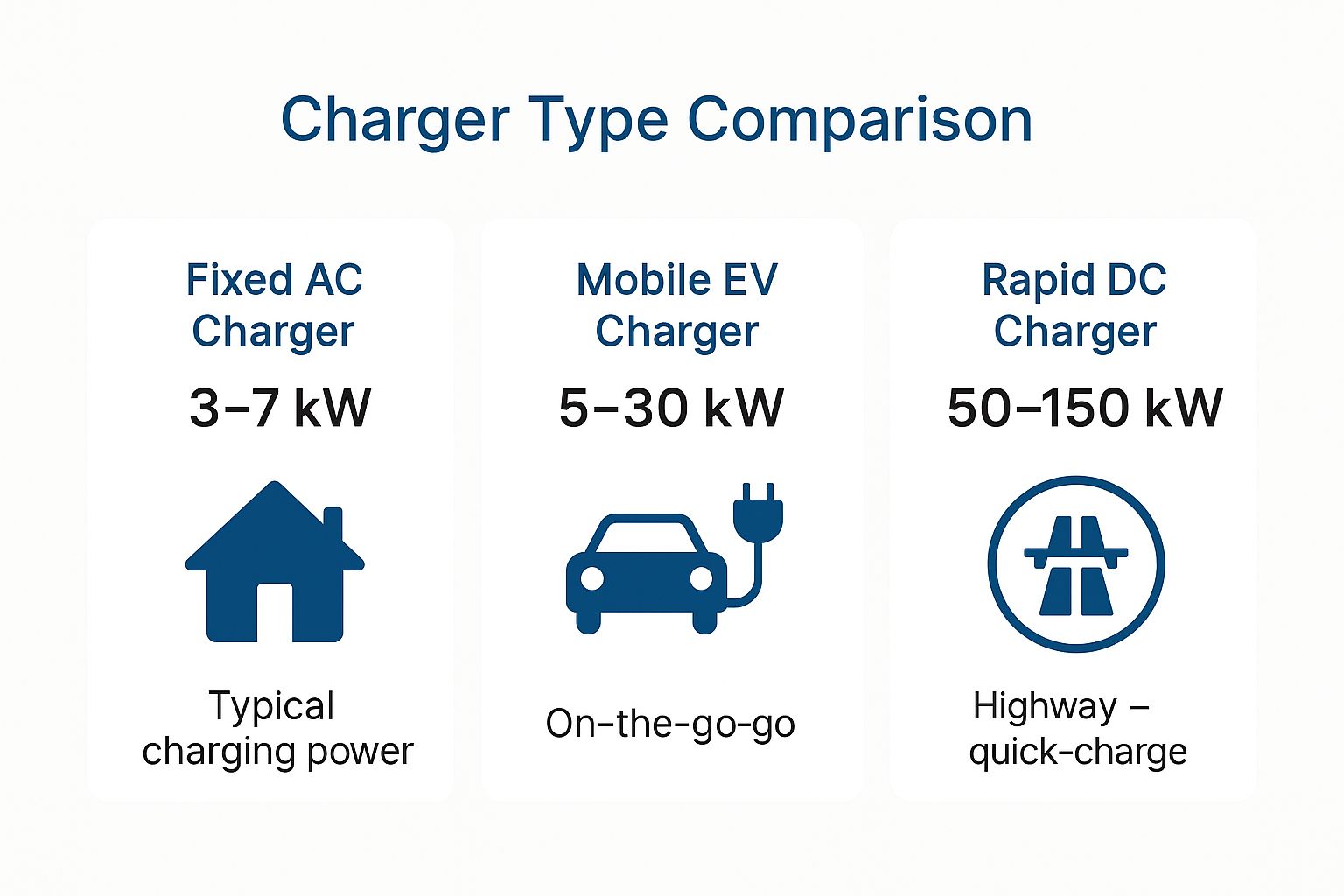
As you can see, while fixed AC chargers are the standard for daily use, rapid DC chargers provide the high-speed power essential for en-route charging and keeping commercial vehicles on the move.
Comparison of EV Charging Solution Types
Choosing the right charger comes down to balancing speed, location and cost. This table breaks down the key differences between the main types of EV charging solutions to help you decide which is the best fit.
| Charger Type | Typical Use Case | Charging Speed | Key Advantage |
|---|---|---|---|
| Fixed AC Charger | Home, workplace, retail parks | Slow to Medium (e.g., 3-8 hours) | Cost-effective and ideal for long-dwell parking |
| Mobile EV Charger | Roadside assistance, events, fleets | Varies (can be fast) | Unmatched flexibility and on-demand power |
| Rapid DC Charger | Motorway services, charging hubs | Very Fast (e.g., 20-40 minutes) | Minimises downtime for long journeys |
Each type plays a vital role in the EV ecosystem. Fixed chargers provide the everyday background charging, mobile units fill the gaps and rapid chargers make long-distance electric travel a practical reality.
Of course, understanding the technical details, like kilowatt (kW) ratings and charging curves, is key to selecting the right technology. For a deeper dive into the mechanics, you can explore our guide to fast charger electric vehicle technology. Matching the charger’s capabilities to your vehicle and daily driving needs ensures you invest in a solution that truly works for you.
Integrating Renewables and Battery Storage
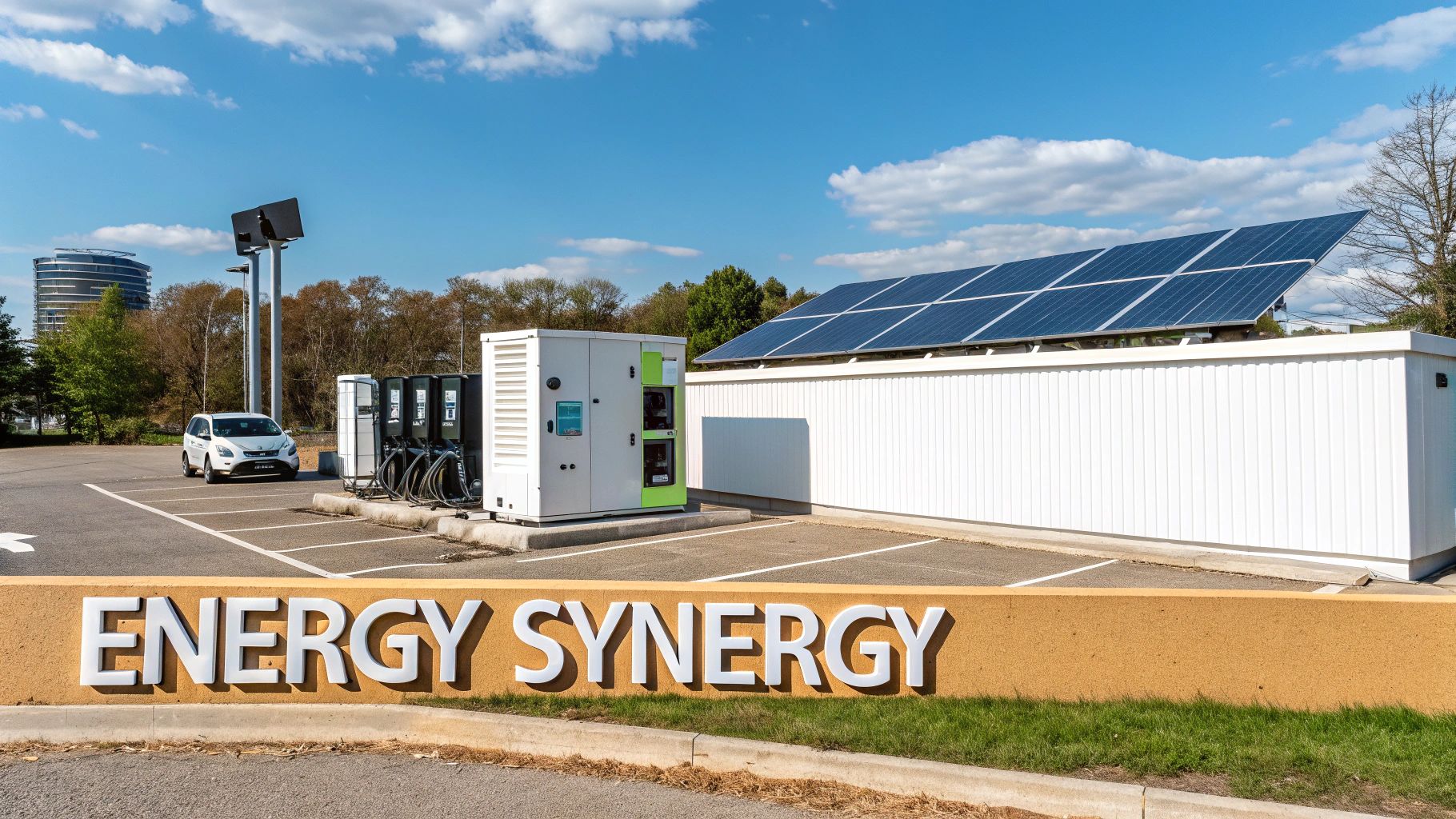
An EV charger solution truly comes into its own when it stops being a standalone unit and starts acting as part of a complete energy ecosystem. By combining chargers with on-site renewables like solar panels and a Battery Energy Storage System (BESS) , businesses can build a resilient, cost-effective and self-sufficient energy hub. This synergy turns a simple charging point into a dynamic asset.
Think of your business's energy use like a household budget. On-site renewables, such as solar, are your income. Your EV fleet is a significant but necessary expense and the battery acts as your savings account. This setup lets you store energy when it's cheapest (or free from the sun) and then use it when grid prices are highest or when demand outstrips supply.
This smart combination of EV charging and batteries unlocks powerful financial and operational advantages. It is no longer just about powering vehicles; it is about transforming your site into a small-scale, intelligent energy network.
The Power of Combined On-Site Renewables
Integrating solar panels directly with your EV charger solution is the first real step towards energy independence. It allows you to power your fleet with clean, self-generated electricity, dramatically reducing your reliance on the grid and shielding your business from volatile energy prices. During daylight hours, your vehicles can be charged directly from solar power, meaning you pay nothing for the energy they consume.
But what about the excess energy your solar panels generate? It does not have to go to waste. Instead of selling it back to the grid for a minimal return, it can be stored in a BESS for later use. This ensures that even after the sun goes down, you can keep charging your vehicles using the free solar energy you captured during the day.
This closed-loop system is the foundation of a modern distributed energy strategy. It minimises energy costs, lowers your carbon footprint and provides a level of operational resilience that a grid-only connection simply cannot match.
Slashing Costs with Grid Scale Batteries
A BESS is the critical link that makes this entire system work together seamlessly. Its main job is to store energy but its value goes far beyond simple storage. By enabling sophisticated energy management strategies, a BESS can deliver a significant return on investment.
One of its most valuable functions is peak shaving . Electricity grids often charge much higher rates during periods of peak demand. A battery allows you to avoid these costly tariffs by discharging stored, low-cost energy to power your chargers instead of drawing from the grid.
On top of that, a battery provides crucial backup power. In the event of a grid outage, a BESS can ensure your charging operations continue uninterrupted, keeping your fleet on the road and your business running smoothly. This is absolutely vital for organisations where vehicle uptime is non-negotiable.
Building a Future-Proof Distributed Energy System
This combination of EV charging, batteries and renewables creates a highly efficient distributed energy system. Instead of relying on a distant, centralised power station, you generate, store and use energy right where you need it. This local approach offers several key benefits that make your infrastructure far more robust and sustainable.
- Enhanced Grid Stability: By managing your own energy, you reduce the strain on the local electricity network, which is especially important when deploying rapid EV charging.
- Greater Energy Security: On-site generation and storage guarantee power availability, making your operations immune to grid failures or blackouts.
- Improved Sustainability Credentials: Powering your fleet with renewable energy showcases a powerful commitment to environmental responsibility, strengthening your brand reputation.
Ultimately, this integrated approach is the future. It provides the financial savings, operational resilience and environmental benefits necessary to build a truly sustainable charging infrastructure that works for your bottom line and for the planet.
Overcoming Constrained Grid Connections
One of the biggest hurdles to installing powerful, rapid EV charging is a weak or constrained grid connection. It is a common problem. Many ideal locations for charging hubs—think retail parks, service stations or remote logistics depots—simply do not have the electrical muscle to support multiple high-powered chargers running all at once.
This often leads to a dead end: the need for costly and painfully slow grid upgrades that can take months or even years to complete.
But a constrained grid connection doesn't have to be a deal-breaker. Modern EV charging solutions are built to solve this exact problem. By using smart technology, businesses can deploy reliable, rapid charging even where the grid is weak, sidestepping the long wait for network reinforcement by creating a self-sufficient energy system right on-site.
The trick is to stop thinking of the grid as the only source of power. Instead, see it as just one piece of a much bigger, more intelligent system. By adding assets like batteries and smart software, you can manage power flows dynamically, giving drivers a seamless charging experience without ever tripping the local infrastructure.
Grid-Scale Batteries: The Power Reservoir
The most powerful tool for beating grid limitations is a Battery Energy Storage System (BESS) . The best way to think of a grid-scale battery is like a reservoir. It can fill up slowly with electricity during off-peak hours when demand and prices are low, drawing a steady, manageable flow that the local grid can easily handle.
Then, when charging demand spikes, the BESS can unleash a massive flow of stored energy to power multiple rapid chargers at the same time. This instant burst of power ensures a top-quality user experience without ever pulling more from the grid than the connection allows. It is the ultimate buffer between your chargers and the utility network.
This is what makes battery-backed EV charging possible in places that would otherwise be completely unsuitable. You can find out more about how these integrated systems work by exploring our battery-backed EV charging systems. It is the technology that makes rapid charging deployment faster, cheaper and viable in far more locations.
Smart Charging and Load Management
If batteries provide the raw power, intelligent software is the traffic controller for your site's energy. Smart charging and load management software is the brain of the whole operation. It constantly watches the grid connection and the real-time demand from every vehicle plugged in.
This software directs power intelligently, sharing out the available energy based on priority, a vehicle's state of charge or its scheduled departure time. For instance, if several cars are plugged in at once, the system can dynamically tweak the charging rate for each one, guaranteeing the site’s total power limit is never breached.
This intelligent management is absolutely critical. It ensures you can offer a reliable charging service within the physical limits of your grid connection, preventing tripped circuits and eye-watering demand charges while serving the maximum number of vehicles.
This capability is becoming more important by the day. The UK's infrastructure is expanding rapidly to keep up with demand. Between January 2023 and January 2025, publicly accessible charging devices shot up from around 46,000 to over 82,000 —an increase of nearly 80% . More specifically, rapid chargers delivering 50kW or more are vital for cutting down waiting times and their numbers have climbed significantly to meet driver expectations.
The Benefits of a Combined Approach
By combining grid-scale batteries with smart load management, any business can build a powerful and resilient EV charging solution, no matter what its grid connection looks like. This integrated strategy delivers some serious advantages:
- Avoids Costly Grid Upgrades: It completely sidesteps the huge expense and long delays that come with utility-led infrastructure work.
- Maximises Site Potential: It lets you install far more chargers and serve more customers than a direct-to-grid connection ever could.
- Enables Revenue Stacking: The energy stored in the BESS can be used for other grid services, creating extra revenue streams on top of EV charging.
- Future-Proofs Your Investment: The system is built to scale. As your charging demand grows, your infrastructure can adapt, ensuring it remains a valuable asset for years to come.
Ultimately, this approach turns a major obstacle into a strategic advantage. It allows businesses to establish a strong presence in the booming EV charging market by delivering the fast, reliable power that drivers demand, anywhere.
How to Choose the Right EV Charger Solution
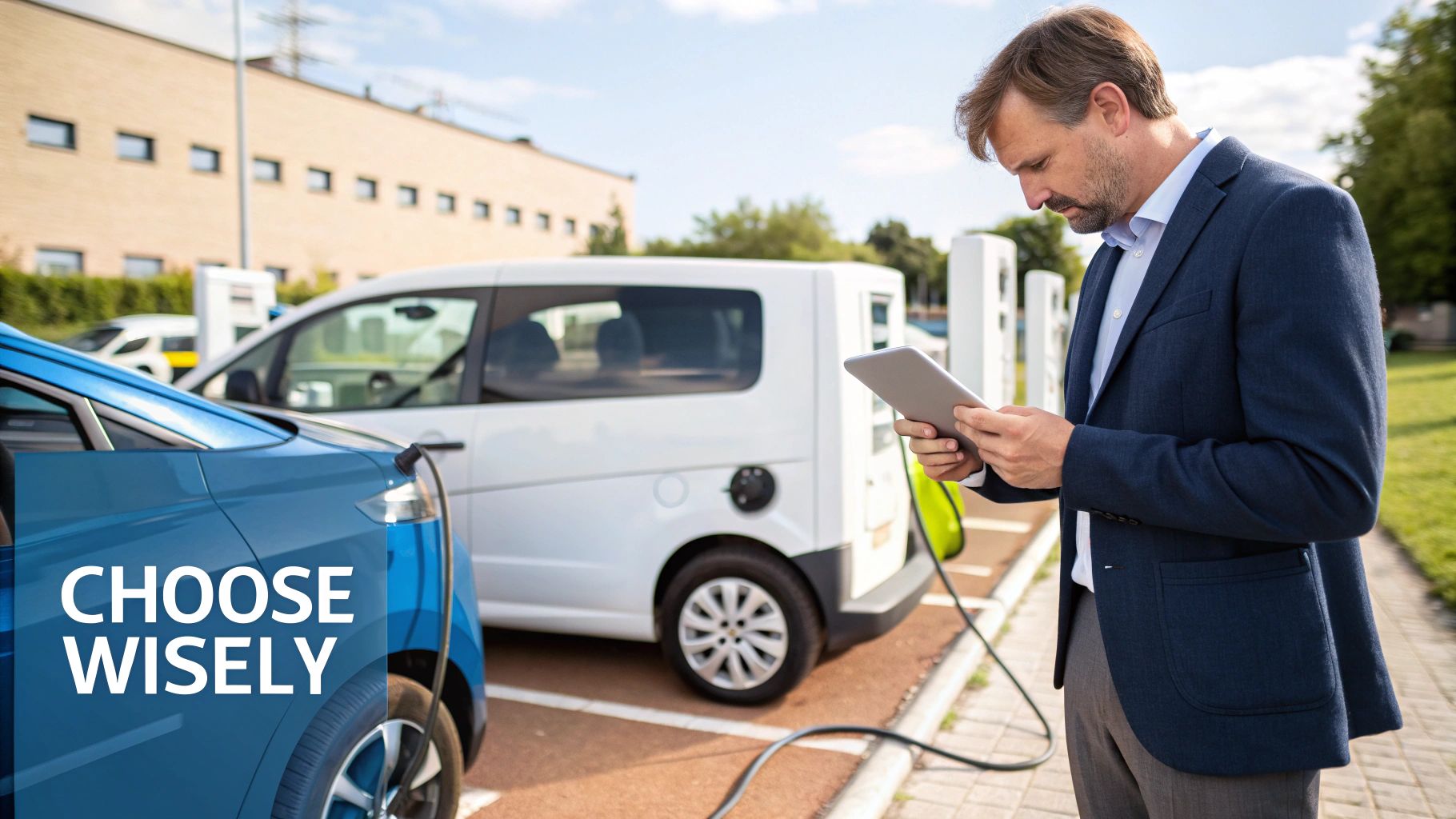
Picking the right EV charging setup is a big strategic decision and it goes way beyond just choosing the hardware off a shelf. To make sure your investment pays off for years to come, you need a solid game plan that lines up with your day-to-day operations, budget and future ambitions. It means looking at the whole picture—from your site’s electrical muscle to what it will really cost to run the chargers over their lifetime.
Getting this right requires a proper look at your specific situation. A logistics firm with a fleet of electric vans has completely different demands than a retail park hoping to attract EV drivers for an hour or two. By breaking it all down into simple, logical steps, you can confidently land on a system that delivers genuine value.
The UK's charging network is expanding at a blistering pace. In Q3 2025 alone, almost 4,000 new public charge points went live, a 4% jump in just three months. This growth, fuelled by both public and private money, really brings home why choosing a future-proof EV charger solution is so critical. You can read more about these quarterly infrastructure statistics to get a sense of where the market is heading.
Analyse Your Charging Demand
First things first: you need to figure out who you're charging for and what their habits are. Are you providing power for a commercial fleet that docks back at the depot overnight? Or are you serving public visitors who just need a quick top-up while they shop?
Get to grips with factors like:
- Dwell Time: How long do vehicles stick around? If they’re parked for hours, slower AC chargers will do the job perfectly. If it’s a quick in-and-out, you’ll need the punch of a rapid DC charger.
- Vehicle Types: Not all EVs are created equal. They have different battery sizes and can handle different charging speeds. Make sure the hardware you pick can serve the cars or vans you expect to see.
- Peak Demand Hours: When is charging going to be most crucial? Knowing this helps you manage your energy use and avoid tripping the system when things get busy.
Assess Your Site’s Electrical Capacity
Before you do anything else, you absolutely must check your site's connection to the grid. A classic mistake is to invest in powerful rapid chargers only to find out the local grid can't handle the load. That’s a recipe for expensive delays and surprise upgrade bills.
A professional site survey isn’t optional—it’s essential. It will tell you the maximum power you can draw and flag whether a constrained grid connection means you’ll need an integrated solution with battery storage to buffer the energy demand.
This assessment is the bedrock of your entire project. It dictates what's actually possible without having to dig up the car park and run new cables from the substation.
Calculate the Total Cost of Ownership
The price tag on the charger is just the beginning. To make a smart financial move, you have to work out the Total Cost of Ownership (TCO) , which covers every single expense over the system's entire life.
Your TCO calculation needs to include:
- Hardware Costs: The price of the chargers themselves.
- Installation Fees: This covers all the electrical work, any digging and getting the system commissioned.
- Software Subscriptions: The ongoing fees for the platform that manages the chargers.
- Maintenance and Support: Annual contracts to keep things running smoothly and fix them when they don’t.
- Energy Costs: The price of electricity, which you can reduce with on-site solar or battery storage.
By adding all this up, you can properly compare different suppliers and solutions. Don’t be afraid to ask potential partners for a detailed TCO projection; it's a crucial step that ensures there are no nasty surprises waiting for you down the line. It gives you the full picture, helping you choose a system that’s not just affordable today but sustainable to operate for years.
Got Questions About EV Charging? We've Got Answers.
As you start exploring the right EV charging setup for your business, it’s only natural for practical questions to pop up. Making an informed decision means getting your head around the technical differences, the real-world benefits of integrated systems and everything in between. We're here to tackle some of the most common queries we hear from businesses just like yours.
Think of this as your straightforward guide to the essentials of modern charging infrastructure. We’ll break down the differences between charger types, explain how to get around grid constraints and show you how adding renewables and batteries can build a more resilient and cost-effective energy ecosystem for your site.
What’s the Difference Between a Fast and a Rapid EV Charger?
The biggest difference between fast and rapid chargers comes down to their power output, which directly dictates how quickly they can charge a vehicle. Getting this right is crucial for matching the hardware to your site’s needs and what your drivers expect.
-
Fast Chargers (AC): These chargers provide alternating current (AC) power, typically at 7kW to 22kW . They’re a great fit for places where vehicles will be parked for a few hours—think workplaces, retail parks or hotels. As a rule of thumb, they can add about 30-80 miles of range for every hour they’re plugged in.
-
Rapid Chargers (DC): A rapid charger delivers high-power direct current (DC) at 50kW or more , feeding electricity straight into the vehicle's battery. This bypasses the car's own onboard converter, which is much slower, allowing for a massive speed boost. You'll find these at motorway services and busy public hubs, where they can add up to 100 miles of range in just 20-30 minutes .
Can I Install EV Chargers if My Site Has a Constrained Grid Connection?
Yes, absolutely. It is one of the most common hurdles businesses face but installing a powerful EV charging solution is entirely possible even with a limited grid connection. Modern systems are designed specifically to solve this problem without forcing you into expensive and time-consuming grid upgrades.
The secret is smart energy management. Instead of trying to pull a huge amount of power from the grid all at once, an integrated system uses other on-site assets to handle the load.
The most effective tool for this is a Battery Energy Storage System (BESS) . It works like an energy reservoir for your site, quietly charging up during off-peak hours when grid demand is low and electricity is cheaper. When a vehicle plugs in for a rapid charge, the BESS instantly discharges its stored power, shielding the local grid from a sudden, heavy demand.
On top of this, intelligent load-balancing software works in the background to dynamically distribute the available power across all your chargers. This makes sure the total load never overwhelms your grid connection, guaranteeing a smooth and reliable service for every driver.
How Does Integrating Solar Panels with EV Charging Benefit My Business?
Pairing solar panels with your EV chargers is a game-changer. It unlocks huge financial and environmental wins, effectively turning your site into its own self-sufficient energy hub. You move from being just another energy consumer to an active energy producer.
First off, it dramatically cuts your operating costs. You get to charge vehicles using free, clean electricity generated right on your property. This gives you a powerful shield against the volatile and ever-rising cost of grid energy.
Secondly, it shrinks your carbon footprint and seriously boosts your company’s green credentials—a powerful way to stand out to environmentally-conscious customers and stakeholders. When you add a battery into the mix, you also gain energy independence, keeping your chargers running even if the grid goes down. It’s a smarter, more reliable and more cost-effective way to power your business.
What Is Distributed Energy and How Does It Connect to EV Charging?
Distributed energy —often called Distributed Energy Resources (DERs)—refers to a decentralised network of smaller-scale power generation and storage technologies. Think assets like solar panels and battery storage, which are located close to where the energy is actually going to be used.
EV charging fits perfectly into this modern energy model. Instead of relying solely on massive, distant power stations, EVs can be charged using locally generated renewable energy. This makes the whole system more efficient because less energy is lost travelling over long transmission lines.
Even better, with new technologies like vehicle-to-grid (V2G), the EVs themselves can become part of the network. They can act as mobile batteries, storing up excess renewable energy and sending it back to support the grid when demand is high. This helps stabilise the entire network, making EV charging a core piece of a smarter, more resilient energy future.
Ready to build a future-proof charging infrastructure for your business? At ZPN Energy , we specialise in delivering integrated rapid EV charging, battery storage, and complete energy management systems. Discover our advanced solutions and take control of your energy future. Explore our EV charger solutions.


